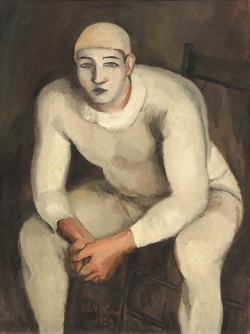The idiosyncrasies of the Gallery’s American modernist collections, the works that cannot be easily categorized, or those created by less well-known figures or by artists whose styles constantly shifted, hint at something essential about the early modernist period in America in general: its inclusive, eclectic, radically democratic spirit and, concomitantly, its passionate belief and defense of independent artistic expression in all forms. Walt Kuhn (American, 1877 - 1949), for example, was a key organizer of the landmark 1913 Armory Show and an adviser to John Quinn, one of the most adventurous American collectors of the early 20th century. But around 1930 Kuhn’s interest in the more radical forms of modernism waned, and he felt little sympathy for the alternative approaches being offered by the regionalists or the social realists. In 1968 and 1972, a group of seven paintings, four still lifes, and three figure paintings from this late period of Kuhn’s career were accessioned by the Gallery. They show an artist who, while well aware of the lessons of Paul Cézanne and Pablo Picasso, was searching for an indigenous, authentic style of painting akin at times to American folk art. Something of the loneliness and anguish of Kuhn’s plight in trying to establish an autonomous artistic identity is registered in The White Clown [fig. 1], a staged depiction of an actor in the role of a circus performer, a work exhibited at the newly opened Museum of Modern Art in 1929.
In a similar but stranger, more morbid, and more forlorn vein are Ivan Albright’s There Were No Flowers Tonight, a 1972 gift from Robert and Clarice Smith that was included in the Museum of Modern Art’s landmark 1943 exhibition American Realism and Magic Realism, and Rico Lebrun’s The Ragged One, a painting accessioned by the Gallery in 1974. Like Kuhn, Albright and Lebrun investigated the plight of figures existing at the edges of society in works that mirrored their own multifaceted personas. That complexity was evident in their far-flung interests and experiences. Albright, born in Chicago, was a medical illustrator for the army in World War I, fascinated by bodily decay and decline. Lebrun, from Naples, Italy, produced a series of harrowing works depicting the Crucifixion and the Holocaust. Both men also coincidentally worked in Hollywood in the early forties: Albright on the portrait featured in MGM’s horror/drama based on Oscar Wilde’s novel The Picture of Dorian Grey (1944) and Lebrun as an animator on Walt Disney’s Bambi (1942). Another example of this type of untamed individualism is Lamar Dodd (American, 1909 - 1996), a southern artist who taught and worked in his home state at the University of Georgia. Winter Valley (anonymous gift, 1971), a bleak view of the outskirts of Athens, Georgia, seems to mark Dodd as a quintessential regional painter. Yet in the 1960s Dodd went on to work for NASA, creating paintings of the Mercury and Apollo space programs, several of which were shown at the Gallery’s exhibition Eyewitness to Space in 1965, and later devoted some of his last canvases to events like the Oklahoma City bombing and the O. J. Simpson trial.
Even works by artists in the collection who more consistently pursued abstraction can complicate standard modernist narratives. In 1988, Raymond Jonson’s Variations on a Rhythm--U (1933) was given to the Gallery by Dr. and Mrs. Robert Fishman. Jonson was born in Iowa and was influenced by the Chicago Armory Show in 1913 and Chicago modernists like B. J. O. Nordfeldt. In 1924 he moved to New Mexico, where he founded the Transcendental Painting Group in 1938. Jonson, in contrast with the artists of the Henri and Stieglitz groups, is representative of the many modernists who, because their careers unfolded outside of New York City, remained outside the dominant histories of modernism written by, and to some extent for, New Yorkers.

